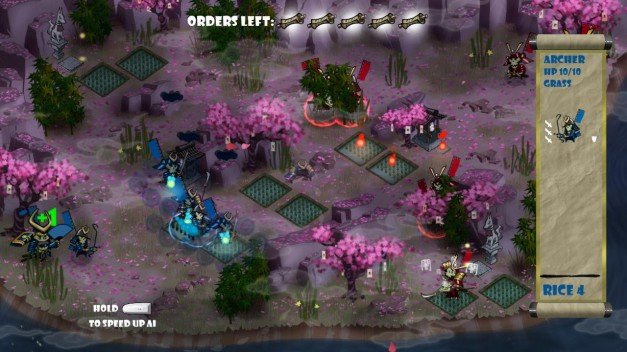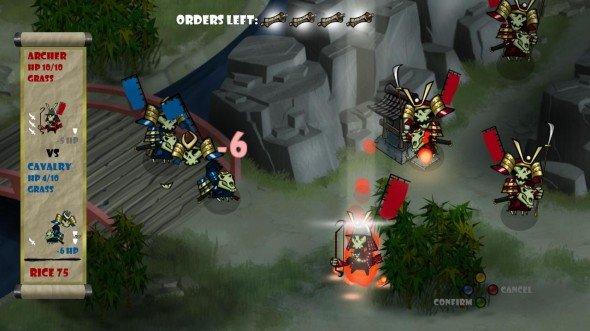Skulls of the Shogun Preview

There can't be that many tactical games where the options on any given turn involve either haunting a rice paddy or devouring the decapitated head of a fallen enemy. IGF contender, Skulls of the Shogun is unusual, no doubt - not only set apart by its comedy undead samurai theme, but by the fact that it brings vigorous new life to its genre.
It's a turnbased tactical game of the kind made popular by the almighty Advance Wars - but instead of reheating that all-too-familiar dish again, as last year's dismal Future Wars and many others have attempted, Skulls seeks to spice up the ingredients. It tosses aside the stricture of the movement grid - instead allowing units to travel anywhere they please within a radius. If they choose, they can attack and then move - or move, attack, then move again - the remaining movement points described by a shrinking circle around them.

I was skeptical at first, given how important positioning is in Advance Wars and its ilk, but actually this analogue movement brings a dramatic ambiguity into play, as you try and size up distances by eye. Placement is still important: drop units side by side and they get a defence boost, becoming an impassable wall. Angle of attack is important, too, since poking someone with a spear can knock them back into environmental hazards, or into the attack radius of another unit.
But while freeform movement is the most visible change from Advance Wars dogma, there are plenty of other small tricks that increase the pace and drama. You're only allowed to issue five orders per turn, meaning that a small but agile force can turn the tide on a much larger one, since a player with many units will not be able to command them all effectively. Turtlers aren't necessarily at an advantage either, since resources (in this case haunted rice paddies) quickly run out, forcing you out of your comfort zone.

Skeletal samurai are hungry folk, it seems. And, as mentioned, they can gobble up the heads of enemies - increasing their power and their health. It's no solution to simply throw more units at the enemy, as for every one they fell, they can potentially become more powerful. But your these super-units can also be your Achilles' heal - a skull-boosted soldier, when cut down, bequeaths not just his own head, but all those he's eaten, allowing for a reversal of fortunes. This is true of your Shogun, too - with two attacks, a generous movement radius and oodles of health, he's by far the mightiest warrior on the field - but if he dies, it's game over.
There are plenty more tricks up Skull's sleeve too - such as capturing shrines which summon animal monks, each with their own upgradeable mystic powers. The fox has a raft of healing spells while the salamander's fire magic offers a big offensive boost. The crow is the most intriguing, with spells that can gust enemies off cliffs, or whisk away spare skulls to more reachable regions.

The campaign itself looks to be a pacey affair, ratcheting up the difficulty from tutorial to truly tough with unusual elegance - but the multiplayer could prove the enduring hook, with up to four players making and breaking temporary alliances in their struggle to be last shogun standing. PC controls have yet to be finalised - the build we played was on a PC, but used a gamepad, as you can see from the screens. Nonetheless, given the skill and attention with which the game has been balanced, I have some faith that mouse and keyboard controls will be just as quick and intuitive. But the greatest accolade is that it's taken what can only be described as a stagnant genre - one which had been revisited countless times with little obvious innovation - and made it feel new and exciting again. Necromancy has never been so welcome.
Keep up to date with the most important stories and the best deals, as picked by the PC Gamer team.

